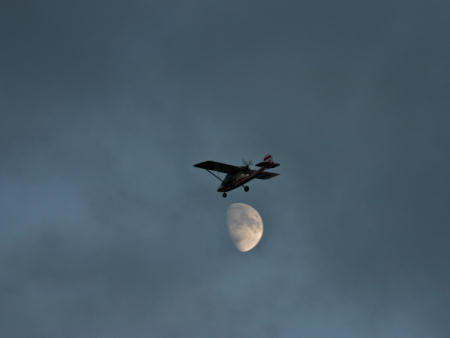The Penfound family's Challenger jumps over the moon on its maiden flight! Audrey Mackey of Bancroft shot this very kewl picture of Bryan Quickmire on the initital test flight of the just completed Challenger II 582. She used a Canon EOS Digital Rebel with a telephoto zoom at a 400mm effective focal length. Download medium 800x600 image. Download large 1024x768 image. (Photo by Audrey Mackey) Audrey's photo could have been titled "Challenger Jumps Over The Moon" however we chose "Two Miles High" from Bryan's diary of the ferry flight the next day when the aircraft was relocated to its new home. You will deduce that it was not his usual low and slow mission - max altitude was 12,000 feet!
Earlier the sky was clear. Now at takeoff
time it's overcast, We launch, point the nose southwest. The overcast develops cracks, becomes broken. Throttle forward and stick back - we loosen
the reins and head up, The ceiling of cloud is soon replaced by
a ceiling of another kind, Throttle back to cruise. Set the pitch trim
for hands off. On the ground it was +15C, a summer morning. The radio monitors 121.5 which is silent. The route is a dogleg. First more south
than west, The clouds are scattered here, broken there, Most clouds top out well below, some reach
up towards us, Caught in glimpses between the white and
gray of the clouds, The vista is constantly changing yet somehow
remains the same. The GPS says the plane is moving over the
ground at 100 mph, We are suspended not just in space but in
time as well. Our turn point lies on the southern edge
of the Canadian Shield. Snippets visible of the ground below Still many blue splotches but now, Up here, two miles high, the tops of most
clouds are a mile below. It occurs to me that this is like a glass
bottomed boat. The bottom of this sea of air is lakes and
rivers, Thirty miles from the destination, the GPS
calls for attention, At 500 fpm it will take 20 minutes to get
down to circuit altitude. If we simply turned the engine off, In that half hour we could glide I ignore the VNAV. It's far too grand up
here Arriving over the destination we are still
two miles high. In spite of our best intentions though,
at the the end of the canyon A one eighty to head south and we eventually
arrive To the east a towering cumulus offers a
better alternative We head over and spiral down around it, Nearing the base we widen the circle, then
head out and away, Now down below 4,000 feet, less than one
mile high, Down, down we go, in a giant racetrack. A low and over to waggle the wings at the
waiting masses. Touch down, taxi in, shut down. No miles high. This coming back to earth is not an easy
transition. (Text by Bryan Quickmire) Most Challengers are flown primarily by one pilot, a few are flown by partners. This Challenger will be flown by three generations of the Penfound family - all at the same time! None were pilots before so five are training concurrently!
To learn and see more order our comprehensive information package and video! |
